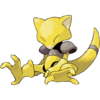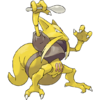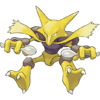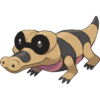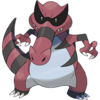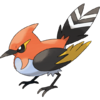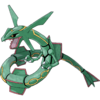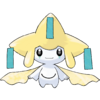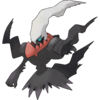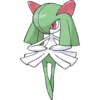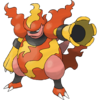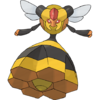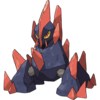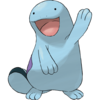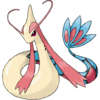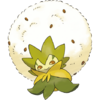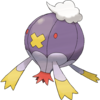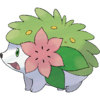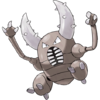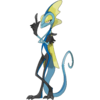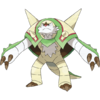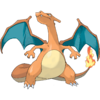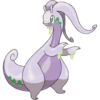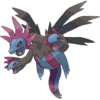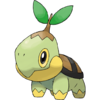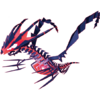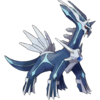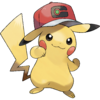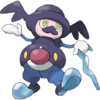Double Chain set 1 (Mezastar): Difference between revisions
mNo edit summary |
mNo edit summary |
||
| Line 8: | Line 8: | ||
Pokémon with the Chain Attack icon could launch successive attacks using up to three of the player's Pokémon. Selecting one of these Pokémon to attack would trigger '''Chain Attack Chance!''' (Japanese: '''チェインアタックチャンス!''') and display icons of the player's other usable Pokémon on the screen. For each icon, two hexagonal graphics would approach its center from opposing sides; pressing the "1" or "2" button when the symbols merged would add that Pokémon to the attack chain. After this phase, players could build a power bonus with the '''Chain Attack Roulette!''' (Japanese: '''チェインアタックルーレット!'''), which consisted of consecutive Attack Roulettes for each Pokémon in the chain. The total power bonus attained from these roulettes was applied to each Pokémon, which would then attack one by one. Again, as with regular attacks, players could quickly press the "1" and "2" buttons during the move animations in attempt boost attack power further. All Pokémon that took part in the Chain Attack would suffer from Tiredness on the player's next turn. Four Grade 5 tags supported the Chain Attack mechanic: {{p|Electivire}}, {{p|Magmortar}}, {{DL|List of Pokémon with form differences|Toxtricity|Amped Form}} {{p|Toxtricity}}, and Low Key Form Toxtricity. The two new mechanics in this set were reminiscent of those introduced in the {{ga-ole|Grand Rush set 1|first Grand Rush set}} from [[Pokémon Ga-Olé]]. | Pokémon with the Chain Attack icon could launch successive attacks using up to three of the player's Pokémon. Selecting one of these Pokémon to attack would trigger '''Chain Attack Chance!''' (Japanese: '''チェインアタックチャンス!''') and display icons of the player's other usable Pokémon on the screen. For each icon, two hexagonal graphics would approach its center from opposing sides; pressing the "1" or "2" button when the symbols merged would add that Pokémon to the attack chain. After this phase, players could build a power bonus with the '''Chain Attack Roulette!''' (Japanese: '''チェインアタックルーレット!'''), which consisted of consecutive Attack Roulettes for each Pokémon in the chain. The total power bonus attained from these roulettes was applied to each Pokémon, which would then attack one by one. Again, as with regular attacks, players could quickly press the "1" and "2" buttons during the move animations in attempt boost attack power further. All Pokémon that took part in the Chain Attack would suffer from Tiredness on the player's next turn. Four Grade 5 tags supported the Chain Attack mechanic: {{p|Electivire}}, {{p|Magmortar}}, {{DL|List of Pokémon with form differences|Toxtricity|Amped Form}} {{p|Toxtricity}}, and Low Key Form Toxtricity. The two new mechanics in this set were reminiscent of those introduced in the {{ga-ole|Grand Rush set 1|first Grand Rush set}} from [[Pokémon Ga-Olé]]. | ||
In addition to the new mechanics, the set continued to feature Pokémon that supported other powered-up gimmicks. Grade 6 Superstar Pokémon {{p|Rillaboom}}, {{p|Cinderace}}, {{p|Inteleon}}, and {{p|Pikachu}} could all [[Gigantamax]], as could Grade 5 Star Pokémon {{p|Gengar}}; Grade 5 {{p|Sirfetch'd}} could similarly [[Dynamax]]. Star Pokémon {{p|Eelektross}} and {{p|Turtonator}} could use [[Z-Move]]s; {{p|Charizard}} and {{p|Gardevoir}} could [[Mega Evolve]]; {{p|Arctozolt}}, {{p|Arctovish}}, and {{p|Haxorus}} also supported the Super Tag mechanic. The remaining Grade 6 Pokémon in the set was {{rf|Hisuian}} {{p|Zoroark}}, which marked one of the first appearances of a Hisuian regional form in Pokémon Mezastar. Five previously featured Superstar Pokémon could also be encountered and obtained as Legacy | In addition to the new mechanics, the set continued to feature Pokémon that supported other powered-up gimmicks. Grade 6 Superstar Pokémon {{p|Rillaboom}}, {{p|Cinderace}}, {{p|Inteleon}}, and {{p|Pikachu}} could all [[Gigantamax]], as could Grade 5 Star Pokémon {{p|Gengar}}; Grade 5 {{p|Sirfetch'd}} could similarly [[Dynamax]]. Star Pokémon {{p|Eelektross}} and {{p|Turtonator}} could use [[Z-Move]]s; {{p|Charizard}} and {{p|Gardevoir}} could [[Mega Evolve]]; {{p|Arctozolt}}, {{p|Arctovish}}, and {{p|Haxorus}} also supported the Super Tag mechanic. The remaining Grade 6 Pokémon in the set was {{rf|Hisuian}} {{p|Zoroark}}, which marked one of the first appearances of a Hisuian regional form in Pokémon Mezastar. Five previously featured Superstar Pokémon could also be encountered and obtained as Legacy tags from August 10, 2022: {{OBP|Lugia|3-004}}, {{OBP|Ho-Oh|2-1-005}}, {{OBP|Galarian Articuno|2-2-003}}, {{OBP|Galarian Zapdos|2-2-004}}, and {{OBP|Galarian Moltres|2-2-005}}. | ||
As with the previous debut set of a new series, all Pokémon Mezastar machines upgraded to run Double Chain featured updated UI graphics. The settlement depicted on the main menu was changed to resemble a more modern train station; the park entrance to Get Now! mode was similarly changed to an area accessed by elevator. More environments were also added to Get in Battle! mode. Tags from the Double Chain series feature different background artwork and began a new numbering system prefixed with "3". | As with the previous debut set of a new series, all Pokémon Mezastar machines upgraded to run Double Chain featured updated UI graphics. The settlement depicted on the main menu was changed to resemble a more modern train station; the park entrance to Get Now! mode was similarly changed to an area accessed by elevator. More environments were also added to Get in Battle! mode. Tags from the Double Chain series feature different background artwork and began a new numbering system prefixed with "3". | ||
Revision as of 14:09, 15 October 2023
|
|
|
The Double Chain series of Pokémon Mezastar began with the release of its premier set on July 7, 2022. It consisted of 70 tags and was the tenth set overall.
Information
The first set in the Double Chain series introduced two new mechanics: Double Move (Japanese: ダブルワザ) and Chain Attack (Japanese: チェインアタック). Pokémon with the Double Move icon had the opportunity to use two moves consecutively. If a player used one of these tags during gameplay, Double Move Chance! (Japanese: ダブルワザチャンス!) would trigger when the Pokémon attacked for the first time and present the player with a roulette consisting of fail spaces and Double Move spaces. Successfully selecting a Double Move space would move onto the next phase, during which players were encouraged to press the "1" and "2" buttons in effort to increase the power of each move. After this phase, the Pokémon would attack twice in succession. As with regular attacks, players could quickly press the "1" and "2" buttons during the animations that played in attempt boost attack power further. If the player managed to launch a Double Move, the game forewent the Attack Roulette and Support Roulette for that turn. Five Pokémon supported this mechanic, all of which were Grade 6: Zacian, Zamazenta, Solgaleo, Lunala, and Obstagoon.
Pokémon with the Chain Attack icon could launch successive attacks using up to three of the player's Pokémon. Selecting one of these Pokémon to attack would trigger Chain Attack Chance! (Japanese: チェインアタックチャンス!) and display icons of the player's other usable Pokémon on the screen. For each icon, two hexagonal graphics would approach its center from opposing sides; pressing the "1" or "2" button when the symbols merged would add that Pokémon to the attack chain. After this phase, players could build a power bonus with the Chain Attack Roulette! (Japanese: チェインアタックルーレット!), which consisted of consecutive Attack Roulettes for each Pokémon in the chain. The total power bonus attained from these roulettes was applied to each Pokémon, which would then attack one by one. Again, as with regular attacks, players could quickly press the "1" and "2" buttons during the move animations in attempt boost attack power further. All Pokémon that took part in the Chain Attack would suffer from Tiredness on the player's next turn. Four Grade 5 tags supported the Chain Attack mechanic: Electivire, Magmortar, Amped Form Toxtricity, and Low Key Form Toxtricity. The two new mechanics in this set were reminiscent of those introduced in the first Grand Rush set from Pokémon Ga-Olé.
In addition to the new mechanics, the set continued to feature Pokémon that supported other powered-up gimmicks. Grade 6 Superstar Pokémon Rillaboom, Cinderace, Inteleon, and Pikachu could all Gigantamax, as could Grade 5 Star Pokémon Gengar; Grade 5 Sirfetch'd could similarly Dynamax. Star Pokémon Eelektross and Turtonator could use Z-Moves; Charizard and Gardevoir could Mega Evolve; Arctozolt, Arctovish, and Haxorus also supported the Super Tag mechanic. The remaining Grade 6 Pokémon in the set was Hisuian Zoroark, which marked one of the first appearances of a Hisuian regional form in Pokémon Mezastar. Five previously featured Superstar Pokémon could also be encountered and obtained as Legacy tags from August 10, 2022: Lugia, Ho-Oh, Galarian Articuno, Galarian Zapdos, and Galarian Moltres.
As with the previous debut set of a new series, all Pokémon Mezastar machines upgraded to run Double Chain featured updated UI graphics. The settlement depicted on the main menu was changed to resemble a more modern train station; the park entrance to Get Now! mode was similarly changed to an area accessed by elevator. More environments were also added to Get in Battle! mode. Tags from the Double Chain series feature different background artwork and began a new numbering system prefixed with "3".
Players with Memory tags could take advantage of a number of gameplay features. During the period between the set's launch and September 14, 2022, players who scanned a Memory tag at least once a week would earn a stamp. Accumulating two of these would unlock summer top Fashion Items for players to customize their avatar; four stamps would unlock a Superstar Sensor; five stamps would unlock a Hisuian Zoroark Emblem; all six stamps would unlock another Superstar Sensor. Players with the Hisuian Zoroark Emblem would then have a chance to add Hisuian Zoroark to their Support Pokémon roster during Get in Battle! mode. Players with Memory tags could also unlock up to three new Partner Pokémon from this set: Abra, Sandile, and Fletchling, which could be evolved through to their final stages by amassing Star Points. Double Star Points could be earned in two stints over the course of the set: between August 11 and 24, 2022 and between September 1 and 14, 2022. Players using the Mezastar Club at any time during the duration of this set could also receive a digital Support Pokémon Ticket for a Lucario and a Present Ticket to unlock two-tone pants and shoes Fashion Items. A limited Present Ticket for Fashion Items that comprised swimming wear could be redeemed through the club between July 15 and 28, 2022.
The Trainer and Battle lineup for this set included two returning Trainer classes in Mountaineer and Tour Guide, two new Trainer classes in Hot-Blooded Teacher and Bug Catcher Girl, and a new Star Trainer named Hasasu. Mezastar Club members could redeem Battle Tickets for each opponent and challenge them to unlock new customization options for their avatar. As part of a tie-in with the anime, Pokémon Trainers taking part in the Masters Eight Tournament could also randomly challenge the player as a Trainer and Battle opponent. Ash, Alain, Diantha, and Iris appeared in this set, while the remaining four appeared in the following set. These opponents did not offer trophies or Fashion Items but players were given the option to dispense a tag featuring one of their Pokémon after a battle. These Pokémon could not be encountered while playing Get in Battle! mode. A special Battle Ticket was later made available as part of a giveaway campaign at participating Namco arcades and could be used on machines between July 28 and November 21, 2022.[1] This ticket allowed players to challenge Star Trainer Hitomi, an opponent that debuted in the fourth set of the original series, albeit with a different team. Participants who defeated Hitomi in battle would unlock an Eternatus T-shirt Fashion Item for their avatar. Ash and Galar Champion Leon could also be challenged as Trainer Tag Battle opponents for a limited time as part of the ranked Challenge from Ash & Leon! campaign. Pairs that defeated Ash and Leon in battle would unlock Charizard T-shirt Fashion Items for their avatars. Players with the top 100 scores following the end of the campaign also won a certificate. The campaign ran from July 30 until August 24, 2022.[2]
Partner Pokémon
| |||||||||||||||||||||||
| |||||||||||||||||||||||
|
Support Pokémon Tickets
|
| ||||||||||||||||||||||||||
|
|
Trainer and Battle opponents
Trainer Tag Battle opponents
|
Set list
| Tag No. | Name | Type | Grade |
|---|---|---|---|
| 3-1-001 | Rillaboom | ||
| 3-1-002 | Cinderace | ||
| 3-1-003 | Inteleon | ||
| 3-1-004 | Pikachu | ||
| 3-1-005 | Zacian | ||
| 3-1-006 | Zamazenta | ||
| 3-1-007 | Solgaleo | ||
| 3-1-008 | Lunala | ||
| 3-1-009 | Obstagoon | ||
| 3-1-010 | Hisuian Zoroark | ||
| 3-1-011 | Shaymin | ||
| 3-1-012 | Shaymin | ||
| 3-1-013 | Electivire | ||
| 3-1-014 | Magmortar | ||
| 3-1-015 | Toxtricity | ||
| 3-1-016 | Toxtricity | ||
| 3-1-017 | Arctozolt | ||
| 3-1-018 | Arctovish | ||
| 3-1-019 | Sirfetch'd | ||
| 3-1-020 | Eelektross | ||
| 3-1-021 | Turtonator | ||
| 3-1-022 | Gengar | ||
| 3-1-023 | Charizard | ||
| 3-1-024 | Haxorus | ||
| 3-1-025 | Gardevoir | ||
| 3-1-026 | Grookey | ||
| 3-1-027 | Thwackey | ||
| 3-1-028 | Rillaboom | ||
| 3-1-029 | Scorbunny | ||
| 3-1-030 | Raboot | ||
| 3-1-031 | Cinderace | ||
| 3-1-032 | Sobble | ||
| 3-1-033 | Drizzile | ||
| 3-1-034 | Inteleon | ||
| 3-1-035 | Galarian Zigzagoon | ||
| 3-1-036 | Galarian Linoone | ||
| 3-1-037 | Obstagoon | ||
| 3-1-038 | Hisuian Zorua | ||
| 3-1-039 | Hisuian Zoroark | ||
| 3-1-040 | Elekid | ||
| 3-1-041 | Electabuzz | ||
| 3-1-042 | Electivire | ||
| 3-1-043 | Magby | ||
| 3-1-044 | Magmar | ||
| 3-1-045 | Magmortar | ||
| 3-1-046 | Toxel | ||
| 3-1-047 | Toxtricity | ||
| 3-1-048 | Toxtricity | ||
| 3-1-049 | Galarian Farfetch'd | ||
| 3-1-050 | Sirfetch'd | ||
| 3-1-051 | Tynamo | ||
| 3-1-052 | Eelektrik | ||
| 3-1-053 | Eelektross | ||
| 3-1-054 | Larvitar | ||
| 3-1-055 | Pupitar | ||
| 3-1-056 | Tyranitar | ||
| 3-1-057 | Ralts | ||
| 3-1-058 | Kirlia | ||
| 3-1-059 | Gardevoir | ||
| 3-1-060 | Gallade | ||
| 3-1-061 | Spheal | ||
| 3-1-062 | Sealeo | ||
| 3-1-063 | Walrein | ||
| 3-1-064 | Roggenrola | ||
| 3-1-065 | Boldore | ||
| 3-1-066 | Gigalith | ||
| 3-1-067 | Drilbur | ||
| 3-1-068 | Excadrill | ||
| 3-1-069 | Pumpkaboo | ||
| 3-1-070 | Gourgeist | ||
References
|

|
This article is part of Project Arcade, a Bulbapedia project that covers all aspects of Pokémon arcade games. |
